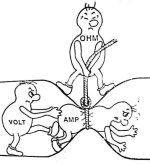k0ua
Epic Contributor
You are correct since ground is an omnipotential path. However my point, to have been simplistic, is that the current densities will be proportional to the resistivity of the substrate. A 60' steel rod (or pipe) has a significant surface area in contact with the ground (dirt in this context) and therefore will have a lower impedance path compared to other paths. Pictures of lightning strikes to the surface sometimes show these paths of highest current density, which implies the lowest resistance.
paul
(ee old guy and former ham operator)
Thank you Paul. Don't be a former...Get back on the horse and rejoin. We are doing new things in digital modes, Band conditions are poor as we are in between cycle 24 and cycle 25, but we have digital modes now that will decode signals at -26 dB below the noise floor in a 2.5khz bandwidth. Get back in, as we need folks with technical expertise. 73 de K0UA

